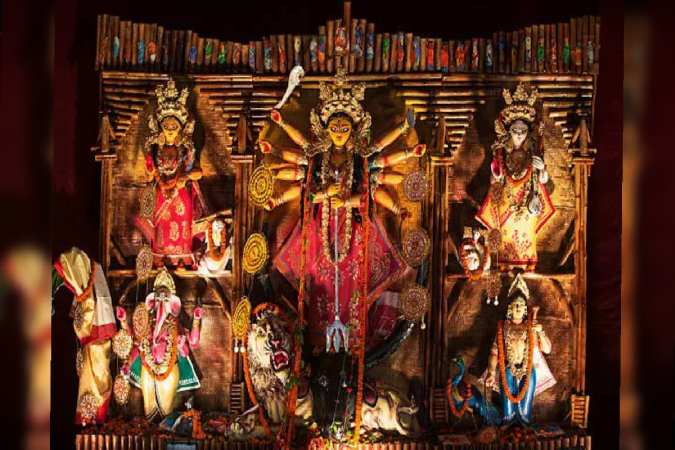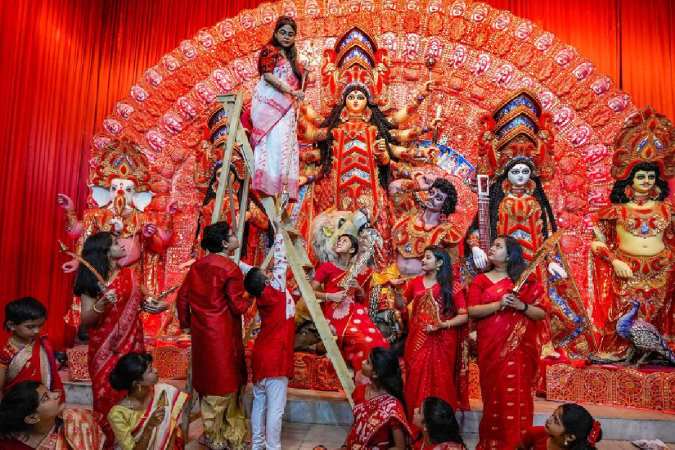How Many Days Left for Durga Puja
When Is Durga Puja 2024?
Goddess Durga will arrive on a palanquin in 2024. The Durgotsav, which refers to the five days of festivities starting from Shashthi and ending on Vijaya Dashami or Dussehra, will begin on October 9 and end on October 13, 2024.
Durga Puja 2024 Calendar:
Mahalaya: Wednesday, October 2, 2024
On Which Vehicle Will Maa Durga Arrive This Year?
In 2024, Goddess Durga will arrive in a Palanquin, and her departure will be in Charanayudha.

How is Durga Puja Celebrated?
Durga Puja Celebrations. The Pandals or shows of the goddess Durga have continuously been the center attraction of this festival.
- Day 1: Mahalaya. The celebrations of Durga Puja begin in Mahalaya.
- Day 2-5: Days of honoring.
- Day 6: Shasti.
- Day 7: Saptami.
- Day 8: Ashtami.
- Day 9 : Navami.
- Day 10: Vijayadashami.
When is Durga Puja 2024: Date and Timings
Observed usually in September or October, Durga Puja is typically celebrated from the sixth to the tenth day of the lively lunar fortnight in the Hindu lunar calendar month of Ashvin.
It is celebrated along with Navratri, the nine-day festival. However, it lasts five days, with Shashthi, Saptami, Ashtami, Navami, and Dashami being the most significant and widely celebrated.
Navratri starts with Ghatasthapana, marking the beginning of the nine auspicious days. Durga Puja officially begins on the sixth day (Shashti), i.e., October 9, 2024, and continues with significant rituals and celebrations, concluding on the tenth day with Durga Visarjan (immersion of the idol), that is, October 12, 2024, as per Drik Panchang.
Check out the table below, outlining all the Durga Puja dates and auspicious timings of the Durga Puja 2024.
| Day | Date | Tithi | Rituals |
| 1st | October 3, 2024 (Thursday) | Pratipada | Ghatasthapana, Shailputri Puja. 2nd |
| 2nd | October 4, 2024 (Friday) | Dwitiya | Chandra Darshana, Brahmacharini Puja. |
| 3rd | October 5, 2024 (Saturday) | Dwitiya | Dwitiya. |
| 4th | October 6, 2024 (Sunday) | Panchami | Saraswati Avahan. |
| 5th | October 7, 2024 (Monday)
|
Shasthi | Saraswati Avahan, Katyayani Puja. Mula Nakshatra Avahan Muhurat is from 10:25 AM to 04:42 PM. |
| 6th | October 8, 2024 (Tuesday) | Panchami | Saraswati Avahan. |
| 7th | October 9, 2024 (Wednesday) | Shasthi | Saraswati Avahan, Katyayani Puja. Mula Nakshatra Avahan Muhurat is from 10:25 AM to 04:42 PM. |
| 8th | October 10, 2024 (Thursday) | Saptami | Saraswati Puja, Kalaratri Puja. |
| 9th | October 11, 2024 (Friday) | Ashtami | Durga Ashtami, Mahagauri Puja, Sandhi Puja, Maha Navami. |
| 10th | October 12, 2024 (Saturday) | Navami, Dashami | Ayudha Puja, Navami Homa, Navratri Parana, Durga Visarjan, Vijayadashami. |
Why is Durga Puja Celebrated: Origin, Significance, and Traditions
The origins of Durga Puja can be traced back to ancient Indian scriptures. According to mythology, Mahishasura was a demon who had established a boon from Lord Brahma that any god or man could not defeat him. It made him powerful, and he caused great distress to the gods in heaven. In response to the gods’ plea for help, Lord Brahma, Lord Vishnu, and Lord Shiva created Goddess Durga, endowing her with their supreme powers to battle Mahishasura.
A fierce battle ensued between Mahishasura and Goddess Durga. To gain an advantage, the demon transformed himself into a buffalo. The conflict lasted for 10 days, and in the end, Goddess Durga emerged victorious by beheading the buffalo and defeating Mahishasura, who appeared in his original form.
In essence, the festival of Durga Puja commemorates this epic battle, spanning over 10 days, with the final day known as Vijayadashami celebrating the triumph of good over evil, in addition to commemorating Goddess Durga’s visit to her parental home with her children.
How Many Days Left for Durga Puja
The celebrations start with Mahalaya, marking the beginning of Goddess Durga’s journey to Earth. The formal festivities start on “Maha Sashthi,” the sixth day, highlighted by the grand unveiling of Durga’s idol to the public amid the vibrant beats of “dhakis” playing the traditional “dhak” drum, a staple of the puja and Bengali tradition.
The next day, “Maha Saptami,” begins with the early morning ritual of immersing a banana tree in water, symbolically transforming it into the “Kola Bou” (Banana Bride), dressed in a saree with a red border and placed beside Lord Ganesha. Some interpret the “Kola Bou” as Ganesha’s bride. In contrast, others see it as a representation of Goddess Durga herself or a sacred assembly of nine plants embodying the goddess’s plant form.
“Maha Ashtami,” the eighth day, is crucial as it commemorates Durga’s triumph over Mahishasura. This day is filled with devotees offering prayers with “Anjali” and enjoying festive meals like khichdi. The following day, “Maha Navami” commences after the “Sandhi Puja,” culminating in the grand “Maha Aarti,” drawing large crowds for participation.
The festivities conclude on “Maha Dashami,” the tenth day, with the immersion of Durga and other deities’ idols in the river Ganges, a ceremony known as “Visarjan.” Before this immersion, married women partake in “Sindoor Khela,” applying vermilion to each other’s faces. The day wraps up with processions and joy, and the tradition of visiting relatives to exchange “Bijoya Dashami” greetings signals the end of Durga Puja.


